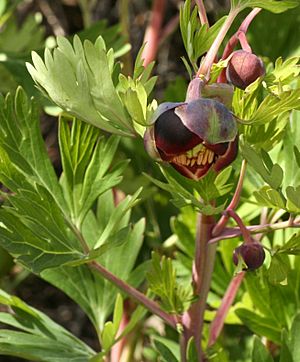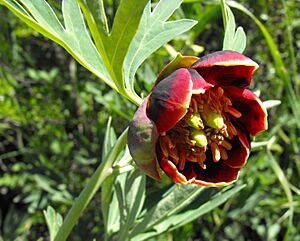Paeonia californica facts for kids
Quick facts for kids Paeonia californica |
|
|---|---|
 |
|
 |
|
| Scientific classification | |
| Genus: |
Paeonia
|
| Species: |
californica
|
| Synonyms | |
|
P. brownii ssp. californica |
|
The Paeonia californica is a special plant known as the California peony. Sometimes people call it the wild peony. It's a perennial plant, which means it lives for many years. It grows to be about 35 to 70 centimeters tall.
This plant is a herbaceous plant, meaning it has soft stems, not woody ones like a tree. In the hot summer, it hides underground. But when the winter rains arrive, it pops back up! It has leaves with many lobes and cup-shaped flowers that hang down. These flowers are a dark maroon color and have many yellow parts called anthers.
The California peony usually blooms from January to March. Sometimes it can bloom as early as December or as late as May. After blooming, each flower makes two to five fruits. This peony is found only in southwestern California, USA, and the very northern part of Baja California, Mexico. It likes to grow on dry hillsides. You can often find it in areas with coastal sage scrub and chaparral plants, especially in the coastal mountains. It often grows under other taller plants.
Some people used to think it was a type of another peony from North America, called Paeonia brownii.
Contents
What Does the California Peony Look Like?
The California peony is a plant that loses its leaves in summer. It grows to be about 35 to 75 centimeters tall. Each stem usually has seven to twelve leaves. These leaves are made up of smaller parts, each about 3 to 9 centimeters long and 1 to 6 centimeters wide. The smallest parts of the leaves are shaped like a line or a small shovel. The leaf parts get narrower slowly towards their stem, or they might not have a stem at all. The tips of the leaves are usually pointy. The leaves are green and not very shiny or pale.
The flowers grow at the top of the stem and hang downwards. They have both male and female parts. The petals are dark red or purplish, sometimes almost black. Their edges are a lighter color. The petals are shaped like an oval and are about 1.5 to 2.5 centimeters long. They are usually longer than the green parts that protect the bud, called sepals.
The flower has many stamens. Each stamen has a thin stalk called a filament, about 0.5 to 0.75 centimeters long. On top of the filament is an anther, which is 0.3 to 0.6 centimeters long. The anthers hold yellow pollen. Each flower usually develops two to five seed pods, called follicles, which are about 3 to 4 centimeters long. The seeds inside are about 1.5 centimeters long. They are slightly curved and have a dull, rough surface. Like all other peonies with two sets of chromosomes, the California peony has ten chromosomes (2n=10).
How is it Different from Similar Peonies?
The California peony is very similar to Brown's peony. They both have small, drooping flowers with small petals. They also have a noticeable center part that is usually made of separate pieces. Their seeds are shaped like cylinders.
However, you can still tell them apart. The California peony is taller, growing 35 to 75 centimeters high. It has seven to twelve green leaves per stem. The leaf parts gradually narrow into their stalk, or they don't have a stalk at all. The smallest parts of the leaves are shaped like a spear or a narrow oval. Brown's peony is shorter, only 20 to 40 centimeters high. It has six to eight pale, bluish-green leaves per stem. Its leaves suddenly narrow at their base, and the smallest parts are egg-shaped.
Also, in the California peony, the petals are egg-shaped and about 1.5 to 2.5 centimeters long, reaching past the sepals. In Brown's peony, the petals are round or wider than long, and only about 0.75 to 1.5 centimeters long, definitely shorter than the sepals.
How Scientists Name and Group the Peony
The California peony, Paeonia californica, was first described in 1838. This was done by Thomas Nuttall in a book called "Flora of North America," which was put together by John Torrey and Asa Gray.
Later, some scientists thought it was just a type of P. brownii. For example, LeRoy Abrams in 1944 and Halda in 1997 thought it was a subspecies. Lynch in 1890 thought it was a variety.
But today, most scientists agree that P. californica and P. brownii are separate species. This is because they have several differences in how they look. They also grow in different environments, and their natural areas do not overlap.
P. brownii and P. californica together form a group called section Onaepia within the Paeonia genus.
Where the California Peony Grows
California peonies grow naturally in southwestern California. This includes counties like Los Angeles, Monterey, Orange, Riverside, Santa Barbara, San Bernardino, San Diego, San Luis Obispo, and Ventura. They also grow in northern Baja California, Mexico, though we don't know as much about their distribution there.
This plant likes to grow on dry hillsides. You can find it in areas with coastal sage scrub and chaparral plants. These are common plant communities in the coastal mountains of Southern and Central California. It often grows as an understory plant, meaning it grows under taller plants. You can find it from sea level up to about 1500 meters high.
Growing California Peonies in Gardens
The California peony is sometimes grown in gardens, especially in native plant landscaping and xeriscaping. Xeriscaping is a way of gardening that uses plants needing very little water.
This plant can handle dry conditions well. It is sensitive to moisture in the summer. If its swollen root gets too much water during the summer, it can rot. It prefers a spot with some sun and can grow in many different types of soil. It seems that deer do not like to eat this plant.


